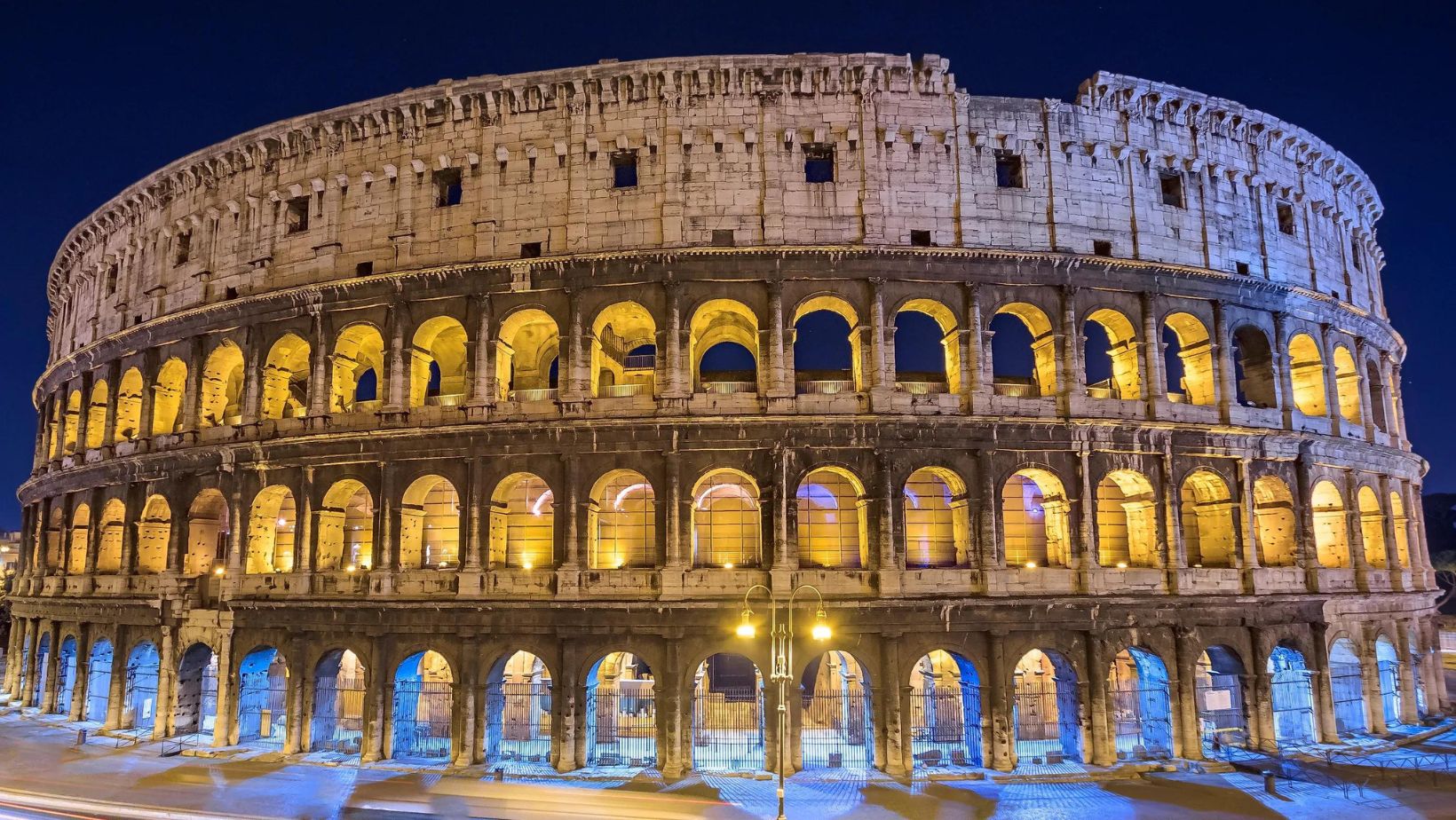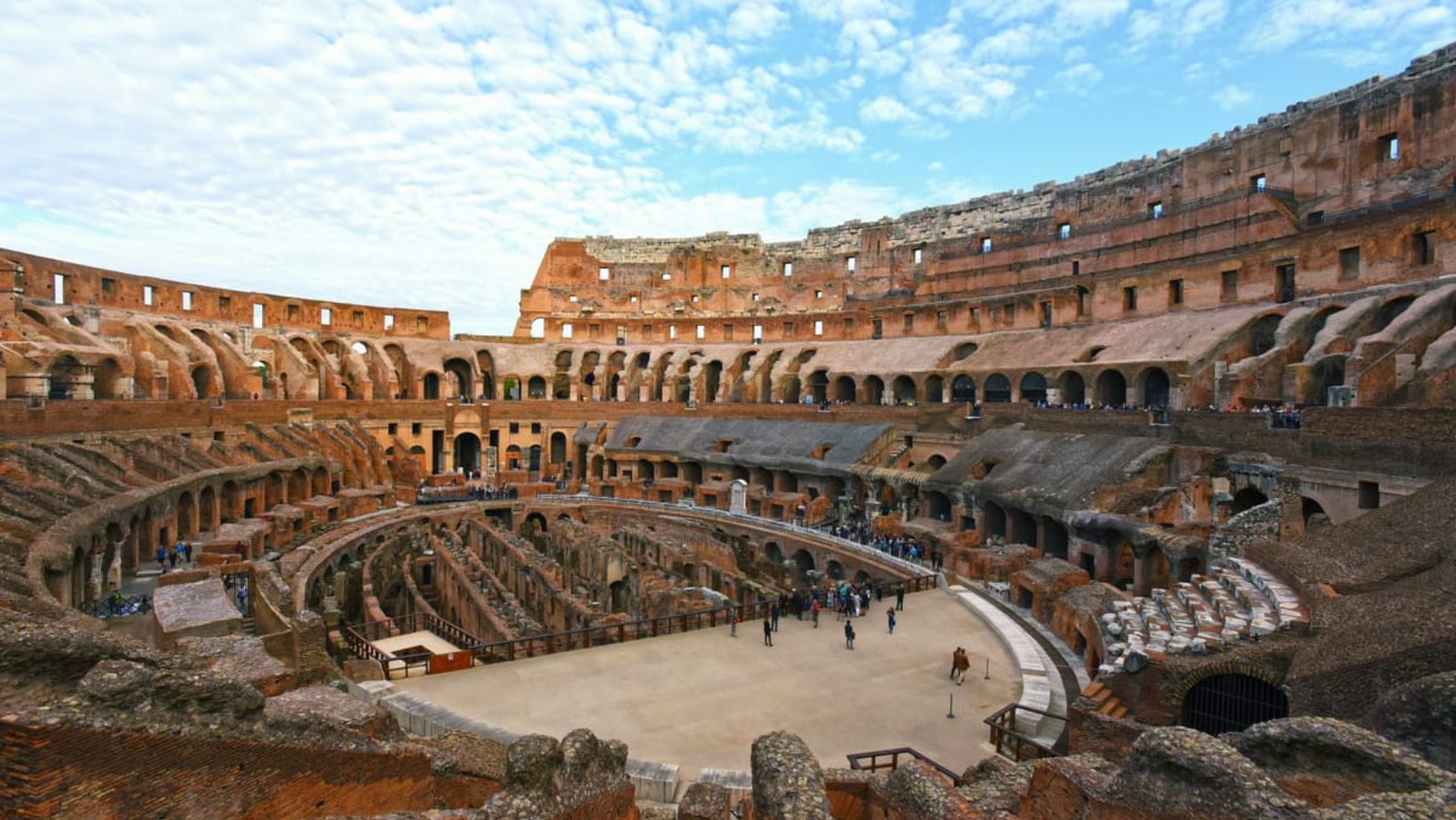Imagine a time when the Roman Empire was at its peak, and a visionary emperor sought to leave his mark on history. That emperor was Vespasian, and his grand project was none other than the Colosseum. I want to take you on a journey back to the 1st century AD, where we’ll uncover the incredible story behind the construction of this awe-inspiring Vespasian Colosseum Construction.
From the ambitious plans laid out by Vespasian to the ingenious engineering techniques employed by Roman builders, we’ll explore every facet of the Colosseum’s creation. Get ready to be amazed by the sheer scale and complexity of this ancient marvel, and discover how it became a symbol of Roman power and ingenuity that endures to this day.
Table of Contents:
- The History and Purpose Behind the Construction of the Colosseum Under Emperor Vespasian
- The Architectural Design and Features of the Flavian Amphitheater
- The Construction Process and Workforce Involved in Building the Colosseum
- The Inaugural Games and Spectacles Held at the Colosseum
- The Lasting Impact and Legacy of the Colosseum in Roman Culture
- Conclusion
The History and Purpose Behind the Construction of the Colosseum Under Emperor Vespasian
Emperor Vespasian came to power in 69 AD, after a tumultuous year of civil war in Rome. As the founder of the Flavian dynasty, he knew he needed to win over the Roman people.
And what better way than with grand public works like the Colosseum?
Vespasian’s Rise to Power and the Need for a Grand Amphitheater

Vespasian was a skilled general who rose through the ranks of the Roman military. When Emperor Nero died in 68 AD, a power struggle ensued. Vespasian emerged victorious, becoming the new Roman emperor.
But he inherited a city in turmoil. Vespasian needed a way to restore stability and gain public favor.
The Symbolic Significance of the Colosseum for the Flavian Dynasty
The Colosseum was more than just an amphitheater—it was a symbol of the new Flavian dynasty. Vespasian chose a strategic location for it, building it on the former site of Nero’s lavish private lake, the signum Neronis.
By replacing Nero’s excess with a public entertainment venue, Vespasian sent a clear message. His rule was for the people, not for personal indulgence. The Colosseum represented Flavian power, wealth, and commitment to the populace.
The Colosseum as a Means to Unite and Entertain the Roman Populace: Vespasian Colosseum Construction
It served an important purpose in uniting Rome’s diverse population. Its free public spectacles, like gladiator fights and animal hunts, appealed to all social classes.
The amphitheater could seat 50,000 to 80,000 people from every walk of life. Vespasian recognized the power of bread and circuses in keeping the masses content.
The Architectural Design and Features of the Flavian Amphitheater: Vespasian Colosseum Construction
The Colosseum was a marvel of Roman architecture and engineering. Its design showcased the empire’s architectural innovations and advanced construction techniques.
Let’s take a closer look at some of its most impressive features.
The Innovative Use of Arches, Vaults, and Travertine Stone
The Colosseum was built using a complex system of arches and vaults. This allowed for its immense size and free-standing structure. Arches and vaults were used to support the seating and distribute the weight evenly.
Travertine, a strong but lightweight limestone, was the primary building material. An estimated 100,000 cubic meters of travertine were used in the Colosseum’s construction. This stone could be easily quarried and transported, ideal for such a massive project.
The Elaborate System of Tunnels, Lifts, and Trap Doors Beneath the Arena: Vespasian Colosseum Construction
Beneath the wooden arena floor was an elaborate underground network called the hypogeum. This consisted of tunnels, chambers, and lifts for staging the spectacles.
Animals and gladiators could be lifted up to the arena floor through a series of trap doors and ramps. The hypogeum also had mechanical hoists to raise and lower scenery and props. This complex system allowed for surprising and dramatic entrances during the games.
The Seating Arrangement and Capacity of the Amphitheater
The Colosseum could hold a staggering number of spectators, with estimates ranging from 50,000 to 80,000. The seating was divided into tiers, reflecting the strict social hierarchy of Roman society.
The emperor and the Vestal Virgins had the best seats, with the senatorial class on the first level. The second and third levels were for lower nobility and common citizens. The top tier was for the poor, slaves, and women. Despite the segregation, the Colosseum brought Romans together in a shared experience.
The Construction Process and Workforce Involved in Building the Colosseum: Vespasian Colosseum Construction
Building the Colosseum was no small feat. It required massive amounts of materials, manpower, and engineering skill. The workforce was large and diverse, including professional builders, engineers, artists, and slaves.
The Role of Jewish Prisoners of War in the Construction
After the Roman victory in the Jewish War of 66-73 AD, many Jewish prisoners were brought to Rome. Some historians believe these POWs were put to work building the Colosseum.
The extent of Jewish involvement is debated, but prisoners of war likely made up at least part of the workforce on this and other large Roman construction projects.
The Contributions of Vespasian’s Sons Titus and Domitian
Vespasian began building the Colosseum but died before its completion. His sons, emperors Titus and Domitian, oversaw the final stages.
Titus is often credited with completing the Colosseum and presiding over its inaugural games in 80 AD. Domitian made some modifications and additions, possibly including the underground hypogeum complex.
The Challenges Faced During the Building Process: Vespasian Colosseum Construction
Constructing the Colosseum was challenging. The site was originally a lake that had to be drained. Massive quantities of stone were needed, requiring extensive quarrying and transportation.
The project required precise engineering, especially for the vaulted arches and underground chambers. Lifting and placing the heavy travertine blocks was an immense challenge that required sophisticated Roman cranes and pulleys.
Careful project management was essential to coordinate the many different trades and laborers involved. Any mistakes in the building process could have been disastrous. But in the end, Roman ingenuity and determination prevailed.
The Inaugural Games and Spectacles Held at the Colosseum: Vespasian Colosseum Construction
In 80 AD, Emperor Titus officially dedicated the Colosseum to a grand 100-day festival. These inaugural games showcased the Roman Empire’s might and the Flavian dynasty’s power.
The spectacles were designed to impress and entertain the Roman populace.
The Opening Ceremonies and 100-Day Inaugural Games
The inaugural games were a lavish and lengthy affair, spanning 100 days. The festivities included gladiator battles, animal hunts, executions, and mock naval battles.
On opening day, Titus led a grand procession of gladiators, exotic animals, musicians, and costumed performers. The games that followed were extravagant displays of imperial wealth and power meant to win the people’s favor.
The Variety of Gladiatorial Contests and Animal Hunts: Vespasian Colosseum Construction
Gladiatorial contests were the main draw of the inaugural games. Gladiators fought in single combat or in staged battles. The amphitheater saw contests between various gladiators, each with their own fighting style and signature weapons.
Animal hunts or “venationes” were also popular. Exotic animals like lions, elephants, and giraffes were imported from the empire. Skilled hunters, called “venatores” or “bestiarii”, fought these beasts in the arena. The inaugural games reportedly involved the slaughter of 9,000 animals.
The Staging of Mock Naval Battles within the Amphitheater
Perhaps the most spectacular events of the inaugural games were the mock naval battles or “naumachiae”. The Colosseum was flooded with water, possibly from a nearby aqueduct, to recreate famous sea battles.
The arena floor was deep enough to float ships but shallow enough for the combatants to stand. These staged battles were a testament to Roman engineering and the empire’s naval might. The fact that the Colosseum could be transformed into a water-filled theater was an impressive feat of Roman ingenuity.
The Lasting Impact and Legacy of the Colosseum in Roman Culture
The Colosseum has endured as a symbol of Rome for nearly 2,000 years. Its impact on Roman culture and identity cannot be overstated.
Even as the empire fell, the Colosseum remained a powerful reminder of Roman engineering, artistry, and imperial might.
The Colosseum as a Symbol of Roman Power and Ingenuity

The Colosseum represented the apex of Roman power and ingenuity. Its sheer size, architectural complexity, and the feats of engineering required for its construction were unmatched in the ancient world.
The amphitheater’s ability to host such a wide variety of spectacles, including gladiator fights, animal hunts, and mock naval battles, was a testament to Roman creativity and ambition. The Colosseum showed that Rome could bend even nature to its will for the entertainment of its people.
The Role of the Amphitheater in Shaping Roman Social Hierarchy
The Colosseum played a key role in reflecting and reinforcing Roman society’s social hierarchy. The seating arrangement mirrored the city’s rigid class divisions, with the best seats reserved for the emperor and the elite.
However, the Colosseum also served to unify Romans across class lines. Rich and poor alike could attend the games, sharing in the excitement and spectacle. In this way, the amphitheater helped to create a sense of shared Roman identity and culture.
The Colosseum’s Influence on Future Amphitheater Designs
The Colosseum set the standard for amphitheater design throughout the Roman world. Its architectural innovations, such as the extensive use of vaulting and the creation of a sub-floor hypogeum, were widely emulated.
The influence of the Colosseum can be seen in the design of amphitheaters across the empire, from the Colosseum of Capua to the Arena of Nîmes in France. Even after the fall of Rome, the Colosseum remained an architectural icon, inspiring countless buildings and stadiums to the present day.
The Colosseum stands as an enduring symbol of Roman culture, power, and ingenuity. Its impact extended far beyond the spectacles held within its walls. The amphitheater shaped Roman society, unified a diverse population, and left an indelible mark on architectural history. Vespasian Colosseum Construction.
Today, the Colosseum remains one of Rome’s most iconic landmarks, attracting millions of visitors each year. It is a testament to the enduring legacy of the Roman Empire and the lasting impact of the Flavian dynasty that built it.
Key Takeaway: Vespasian Colosseum Construction
Emperor Vespasian built the Colosseum to win public favor after civil war. It symbolized Flavian power and replaced Nero’s excess with a venue for all Romans. Using advanced engineering, it hosted diverse spectacles, uniting Rome’s classes under shared entertainment.
Conclusion: Vespasian Colosseum Construction
The construction of the Colosseum under Emperor Vespasian was a turning point in Roman history. It showcased the empire’s wealth, power, and engineering prowess, while also serving as a tool to unite and entertain the masses.
From the innovative use of arches and vaults to the elaborate underground hypogeum, every aspect of the Colosseum’s design was a testament to Roman ingenuity. The amphitheater’s inauguration in 80 AD, with 100 days of spectacular games and events, cemented its place as the grandest stage in the Roman world.
Today, the Colosseum stands as an enduring symbol of the Roman Empire’s legacy. Its influence can be seen in countless stadiums and amphitheaters around the globe, a reminder of the lasting impact of Vespasian’s grand vision. The story of the Colosseum’s construction is one of ambition, innovation, and the indomitable spirit of ancient Rome.

